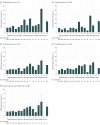Association of Digital Media Use With Subsequent Symptoms of Attention-Deficit/Hyperactivity Disorder Among Adolescents
- PMID: 30027248
- PMCID: PMC6553065
- DOI: 10.1001/jama.2018.8931
Association of Digital Media Use With Subsequent Symptoms of Attention-Deficit/Hyperactivity Disorder Among Adolescents
Abstract
Importance: Modern digital platforms are easily accessible and intensely stimulating; it is unknown whether frequent use of digital media may be associated with symptoms of attention-deficit/hyperactivity disorder (ADHD).
Objective: To determine whether the frequency of using digital media among 15- and 16-year-olds without significant ADHD symptoms is associated with subsequent occurrence of ADHD symptoms during a 24-month follow-up.
Design, setting, and participants: Longitudinal cohort of students in 10 Los Angeles County, California, high schools recruited through convenience sampling. Baseline and 6-, 12-, 18-, and 24-month follow-up surveys were administered from September 2014 (10th grade) to December 2016 (12th grade). Of 4100 eligible students, 3051 10th-graders (74%) were surveyed at the baseline assessment.
Exposures: Self-reported use of 14 different modern digital media activities at a high-frequency rate over the preceding week was defined as many times a day (yes/no) and was summed in a cumulative index (range, 0-14).
Main outcomes and measures: Self-rated frequency of 18 ADHD symptoms (never/rare, sometimes, often, very often) in the 6 months preceding the survey. The total numbers of 9 inattentive symptoms (range, 0-9) and 9 hyperactive-impulsive symptoms (range, 0-9) that students rated as experiencing often or very often were calculated. Students who had reported experiencing often or very often 6 or more symptoms in either category were classified as being ADHD symptom-positive.
Results: Among the 2587 adolescents (63% eligible students; 54.4% girls; mean [SD] age 15.5 years [0.5 years]) who did not have significant symptoms of ADHD at baseline, the median follow-up was 22.6 months (interquartile range [IQR], 21.8-23.0, months). The mean (SD) number of baseline digital media activities used at a high-frequency rate was 3.62 (3.30); 1398 students (54.1%) indicated high frequency of checking social media (95% CI, 52.1%-56.0%), which was the most common media activity. High-frequency engagement in each additional digital media activity at baseline was associated with a significantly higher odds of having symptoms of ADHD across follow-ups (OR, 1.11; 95% CI, 1.06-1.16). This association persisted after covariate adjustment (OR, 1.10; 95% CI, 1.05-1.15). The 495 students who reported no high-frequency media use at baseline had a 4.6% mean rate of having ADHD symptoms across follow-ups vs 9.5% among the 114 who reported 7 high-frequency activities (difference; 4.9%; 95% CI, 2.5%-7.3%) and vs 10.5% among the 51 students who reported 14 high-frequency activities (difference, 5.9%; 95% CI, 2.6%-9.2%).
Conclusions and relevance: Among adolescents followed up over 2 years, there was a statistically significant but modest association between higher frequency of digital media use and subsequent symptoms of ADHD. Further research is needed to determine whether this association is causal.
Conflict of interest statement
Figures


Comment in
-
Digital Media and Symptoms of Attention-Deficit/Hyperactivity Disorder in Adolescents.JAMA. 2018 Jul 17;320(3):237-239. doi: 10.1001/jama.2018.8932. JAMA. 2018. PMID: 30027231 No abstract available.
-
Digital Media Use and ADHD Symptoms.JAMA. 2018 Dec 25;320(24):2599. doi: 10.1001/jama.2018.18095. JAMA. 2018. PMID: 30575870 No abstract available.
References
-
- Nyarko KA, Grosse SD, Danielson ML, Holbrook JR, Visser SN, Shapira SK. Treated prevalence of attention-deficit/hyperactivity disorder increased from 2009 to 2015 among school-aged children and adolescents in the United States. J Child Adolesc Psychopharmacol. 2017;27(8):731-734. doi:10.1089/cap.2016.0196 - DOI - PMC - PubMed
-
- Larsson J-O, Larsson H, Lichtenstein P. Genetic and environmental contributions to stability and change of ADHD symptoms between 8 and 13 years of age: a longitudinal twin study. J Am Acad Child Adolesc Psychiatry. 2004;43(10):1267-1275. doi:10.1097/01.chi.0000135622.05219.bf - DOI - PubMed
Publication types
MeSH terms
Grants and funding
LinkOut - more resources
Full Text Sources
Other Literature Sources
Medical

